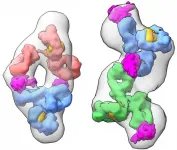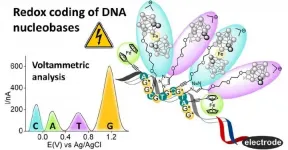(Press-News.org) Vaccines are turning the tide of the pandemic, but the risk of infection is still present in some situations. If you want to visit a friend, get on a plane, or go see a movie, there is no highly accurate, instant test that can tell you right then and there whether or not you have a SARS-CoV-2 infection. But new research from Lawrence Berkeley National Laboratory (Berkeley Lab) could help get reliable instant tests on the market.
A study led by Michal Hammel and Curtis D. Hodge suggests that a highly sensitive lateral flow assay - the same type of device used in home pregnancy tests - could be developed using pairs of rigid antibodies that bind to the SARS-CoV-2 nucleocapsid protein. Such a test would only require a small drop of mucus or saliva, could give results in 15 minutes, and could detect a COVID-19 infection one day before the onset of symptoms. Their work was published in the journal mABs.
The current gold standard tests for COVID-19 use a form of polymerase chain reaction (PCR) to identify the presence of SARS-CoV-2 nucleic acid (RNA) rather than a viral protein. They are quite accurate, with false negative rates ranging less then 5% (depending primarily on the sampling site, sample type, and stage of infection). However, PCR tests must be sent away for analysis at an accredited lab.
Rapid antigen tests use antibodies to detect specific parts of the viral particle itself. Current antigen tests have a very low rate of false positives, but are plagued by high false negative rates, and therefore can't replace PCR tests for definitive COVID-19 diagnosis. If a more accurate antigen test was brought to market, it could serve as a helpful initial screening tool similar to how home pregnancy tests work. In the case of a positive result, the user would need to begin appropriate precautionary measures (isolation and other transmission-prevention behaviors) and then have the diagnosis confirmed by an official test at a health clinic.
"As we move toward gaining normalcy and reopening economies worldwide, there is continued demand for rapid, low-cost tests that can be self-administered without the need for a trained professional," said Hammel, a biophysicist in Berkeley Lab's Biosciences Area. "Currently used COVID-19 PCR tests are expensive, at about $100 per test, and on average, U.S. labs are performing one million tests per day. An accurate rapid antigen test could cost $1 each and eliminate the wait time."
Hammel, Hodge, and their colleagues used small angle X-ray scattering (SAXS) performed at Berkeley Lab's Advanced Light Source (ALS) to examine about 20 antibody-antigen interactions. Their data showed that a particular pair of monoclonal antibodies bound to the nucleocapsid protein very strongly and stably, in part due to the antibodies' rigidity. All antibodies vary in their degree of rigidity based on the amino acid sequence of their "arms," which are the part of the Y-shaped molecules that bind to antigens. "The combination of the two rigid antibodies was also observed to increase networking - a process in which multiple antibodies bound to the same antigen at different sites form larger clumps or 'networks,'" explained Hodge, a postdoctoral researcher and first author on the study.
Antibody networking and high binding stability are known to improve the sensitivity of lateral flow assays, and researchers have long speculated that antibody flexibility plays a role in both properties. But studying the physical dynamics of antibody-antigen pairs to find the most effective antibodies is very difficult with traditional imaging techniques, which require the molecules to be stabilized or crystallized. The SAXS technique developed by Hammel and his colleagues allows scientists to examine antibodies and antigens in their natural state, i.e. when moving freely in a liquid.
"We showed that we can rapidly identify new antibody-antigen pairs that result in a more sensitive detection assay," said Hammel. "This technique could be applied to hundreds of antibodies in a short amount of time to identify the most suitable antibodies to achieve as-of-yet unattained sensitivity of antibody-based diagnostics, which are key for early diagnosis of SARS-CoV-2 as well as other pathogens."
The team is now investigating methods of improving test sensitivity even further.
INFORMATION:
This work was funded through the National Virtual Biotechnology Laboratory (NVBL), a consortium of DOE National laboratories with core capabilities relevant to the threats posed by COVID-19, and funded under the Coronavirus Aid, Relief, and Economic Security (CARES) Act. The ALS is an Office of Science User Facility.
Founded in 1931 on the belief that the biggest scientific challenges are best addressed by teams, Lawrence Berkeley National Laboratory and its scientists have been recognized with 14 Nobel Prizes. Today, Berkeley Lab researchers develop sustainable energy and environmental solutions, create useful new materials, advance the frontiers of computing, and probe the mysteries of life, matter, and the universe. Scientists from around the world rely on the Lab's facilities for their own discovery science. Berkeley Lab is a multiprogram national laboratory, managed by the University of California for the U.S. Department of Energy's Office of Science.
DOE's Office of Science is the single largest supporter of basic research in the physical sciences in the United States, and is working to address some of the most pressing challenges of our time. For more information, please visit END
The first-ever discovery of an extraterrestrial radioactive isotope on Earth has scientists rethinking the origins of the elements on our planet.
The tiny traces of plutonium-244 were found in ocean crust alongside radioactive iron-60. The two isotopes are evidence of violent cosmic events in the vicinity of Earth millions of years ago.
Star explosions, or supernovae create many of the heavy elements in the periodic table, including those vital for human life, such as iron, potassium and iodine.
To form even heavier elements, such as gold, uranium and plutonium it was thought that a more violent event may be needed, such as two neutron stars merging.
However, a study led by Professor Anton Wallner from The Australian National University (ANU) suggests ...
A rigorous meta-analysis of randomized clinical trials (RCTs) that compared the effects of medical therapies alone with medical therapies plus revascularization in patients with stable ischemic heart disease (SIHD) was presented at EuroPCR on May 18, 2021. The study concluded that adding revascularization was associated with a statistically important reduction in cardiovascular death associated with a statistically important reduction in spontaneous myocardial infarction (MI), providing a biologically plausible explanation for the observed benefit.
An international group of investigators performed a meta-analysis of RCTs conducted between 1979 and 2020. Strict entry criteria were established to assure the analysis was restricted to studies involving elective, ...
When it comes sharing recipes on social media, what users post, and what they cook may be two entirely different things. That's the conclusion of a END ...
An international team of scientists from the Menzies Health Institute Queensland (MHIQ) at Griffith University and from City of Hope, a research and treatment center for cancer, diabetes and other life-threatening diseases in the U.S., have developed an experimental direct-acting antiviral therapy to treat COVID-19.
Traditional antivirals reduce symptoms and help people recover earlier. Examples include Tamiflu®, zanamivir and remdesivir.
This next-generation antiviral approach used gene-silencing RNA technology called siRNA (small-interfering RNA) to attack the virus' genome directly, which stops ...
ATLANTA - MAY 18, 2021 - A new study finds breast cancer survivors in general have higher risk of new cancer diagnosis compared to healthy individuals. The article, which appears in CANCER, states that compared to the general population in the United States, the risk of new cancer diagnoses among survivors was 20% higher for those with hormone receptor (HR) positive cancers and 44% higher for those with HR-negative cancers.
Breast cancer is the most commonly diagnosed and prevalent cancer among women in the U.S., with over 3.9 million living breast cancer survivors as of 2019. The number of survivors is expected to increase with the aging population and advances in breast cancer treatment.
Subsequent primary cancer (SPC) after breast cancer is a well-known late effect, but the ...
PULLMAN, Wash. - Alterations in the epigenetic programming of hatchery-raised steelhead trout could account for their reduced fertility, abnormal health and lower survival rates compared to wild fish, according to a new Washington State University study.
The study, published May 18 in Environmental Epigenetics, establishes a link between feeding practices that promote faster growth, as well as other environmental factors in fish hatcheries, and epigenetic changes found in the sperm and red blood cells of of steelhead trout.
The research was done at a national fish hatchery on the Methow River in Winthrop, Washington and at another hatchery ...
An international research team headed by Michal Hocek of the Institute of Organic Chemistry and Biochemistry of the Czech Academy of Sciences (IOCB Prague) and Charles University and Ciara K. O'Sullivan of Universitat Rovira i Virgili (URV) in Spain have developed a novel method for labeling DNA, which in the future can be used for sequencing DNA by means of electrochemical detection. The researchers presented their results in the Journal of the American Chemical Society.
A DNA molecule comprises four basic building blocks, nucleotides. The genetic information carried within the molecule is determined by the order of the nucleotides. Knowledge of the order of these building blocks, which is known ...
CHAMPAIGN, Ill. -- A new coronavirus test can get accurate results from a saliva sample in less than 30 minutes, researchers report in the journal Nature Communications. Many of the components of the hand-held device used in this technology can be 3D-printed, and the test can detect as little as one viral particle per 1-microliter drop of fluid.
"We developed a rapid, highly sensitive and accurate assay, and a portable, battery-powered device for COVID-19 testing that can be used anywhere at any time," said University of Illinois Urbana-Champaign chemical and biomolecular engineering professor Huimin Zhao, who led the research. Though it is still in the ...
A new study published in Nature Communications provides an important new basis for comparing the effectiveness of different tuberculosis treatments.
Tuberculosis, a disease caused by the bacterium Mycobacterium tuberculosis (Mtb), is typically the leading infectious cause of death globally, killing 1.2 million people each year. The availability of a new way to evaluate treatments can save lives.
In the study, faculty at the University of Colorado School of Medicine at the University of Colorado Anschutz Medical Campus partnered with the University of California ...
Scientists at the University of Colorado Boulder have tapped into a poltergeist-like property of electrons to design devices that can capture excess heat from their environment--and turn it into usable electricity.
The researchers have described their new "optical rectennas" in a paper published today in the journal Nature Communications. These devices, which are too small to see with the naked eye, are roughly 100 times more efficient than similar tools used for energy harvesting. And they achieve that feat through a mysterious process called "resonant ...



